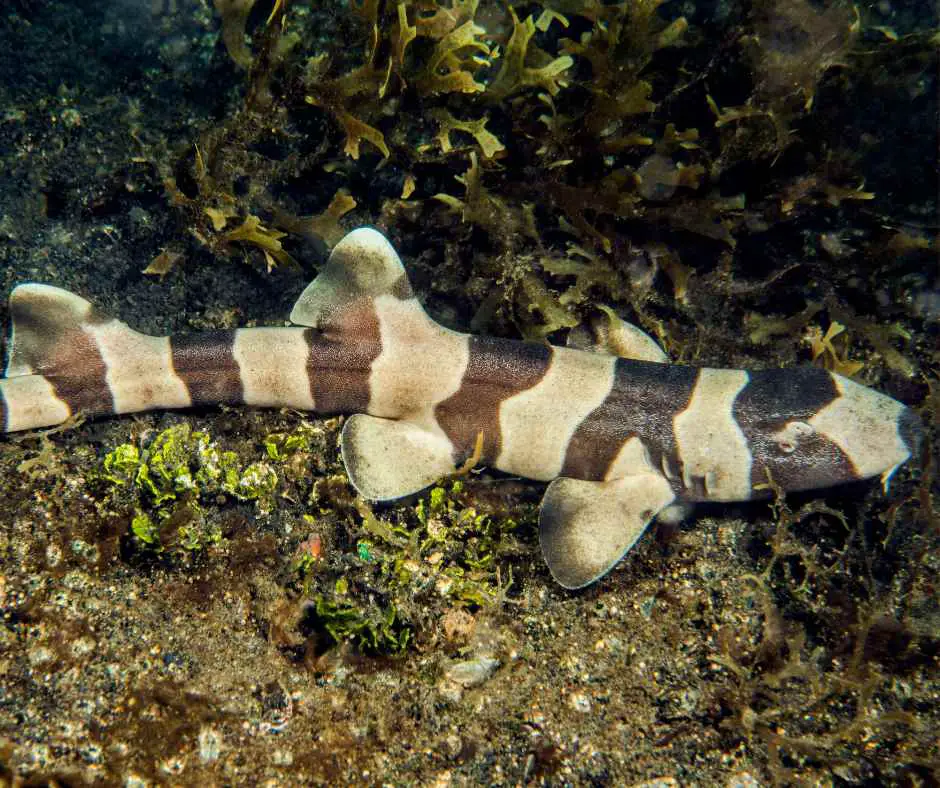The Burmese bamboo shark is a unique species known as Chiloscyllium Burmensis. It is usually present in the Indo-West Pacific region. They belong to the Hemiscylliidae family. Moreover, they are a nocturnal species, meaning they are active at night and rest during the day.

Furthermore, Burmese bamboo sharks are fascinating creatures. Hence, we will discuss them at length in this blog. So, get ready to dive into the shark world today with us!
Burmese Bamboo Shark Facts
From their demeanor to reproduction to hunting habits to structure, all tell something important about this species. Thus, the following are some significant facts;
Burmese Bamboo Shark Habitat
The Burmese bamboo shark habitat includes the shallow coastal waters of the Andaman Sea near the coasts of Thailand and Myanmar. Besides this, you can also find this species in other Indo-West Pacific region countries. For example;
- India
- China
- Singapore
Moreover, the bamboo sharks are also inhabitants of the Southern Coast of New Guinea and the Northern Coast of Australia.
Where Does the Burmese Bamboo Shark Live? / Natural Habitat
Other than regions, it’s necessary to explain what elements constitute the Burmese bamboo shark’s natural habitat. These species typically inhabit water depths ranging from 1 to 30 meters. In addition, they usually live in areas with sandy or muddy bottoms. Such a habitat provides them with a suitable environment to hide and look for food.
Additionally, the bamboo shark can live in both marine and freshwater environments. These species have been observed in brackish waters and mangrove estuaries also. In these places, the salinity levels are lower than in the open ocean. Conversely, their adaptability to lower saline levels makes them an essential subject in studying shark behavior.
Where Does Burmese Bamboo Shark Live? / Artificial Habitat
An aquarium can provide a suitable artificial habitat for the Burmese bamboo shark. However, it must be designed and maintained to meet the shark’s specific needs. Hence, when setting up the aquarium, you must provide enough space for the shark to swim and live comfortably.
A tank size of 180 gallons or more is suitable for a single adult bamboo shark. Also, maintaining proper water conditions for the fish is paramount. Adequate filtration is also crucial to keep the water clean. Moreover, a sound filtration system helps reduce water change frequency.
Finally, the bamboo sharks prefer a dimly lit aquarium with plenty of hiding places. So you can also add a substrate of soft sand or fine gravel. That will provide a comfortable resting area for the fish.
Burmese Bamboo Shark Structure
The bamboo shark structure gives significant insight into its anatomy. The shark has a cylindrical body shape, a flat head, large eyes, and five-gill slits on the sides of the head. Moreover, the shark’s mouth is on the underside of the head. Small, triangular teeth surround the mouth, adapted to crush the prey. In addition, the fish’s body has small, tooth-like denticles. They protect the shark against predators.
Spiracles are also one of the significant organs of this fish species. They are specialized structures used for respiration seen on top of the shark’s head, near the eyes. They function as secondary breathing organs.
The bamboo shark can pump water over its gills. However, it uses its spiracles to breathe while resting on the seafloor. The spiracles allow the fish to receive oxygenated water while not actively swimming. These structures are unique to this species and provide it with a crucial adaptation for survival in its environment.
Another essential shark organ is the cirri. They are sensory structures found on the heads of the bamboo shark. They are typically long, slender, and hair-like. Cirri are the pretty sensitive part of the shark. Thus, the fish uses them to detect changes in its environment. They also help the shark to navigate and locate prey as they can sense the other animals’ movements in the water.
As a result, cirri allow the bamboo shark to be highly effective at hunting even though this species has limited mobility and is not a fast swimmer. Thus, making cirri essential for the shark’s survival in the wild.
Besides, the bamboo shark has two dorsal fins, a small anal fin, and a long, whip-like tail. The tail helps the fish maneuver in tight spaces and escape predators.
Hence, looking at the entire structure of the bamboo shark, we can safely state that its anatomy is best suited for its nocturnal, bottom-dwelling lifestyle.
Burmese Bamboo Shark Color
The Burmese bamboo shark is known for its unique coloration. That sets it apart from other species of sharks. Their body is commonly brown or grayish with patterns of lighter spots and stripes. As a result, it creates a unique and eye-catching appearance.
The patterns on the shark’s body assist the fish in blending in with the rocky or coral-covered bottom of its habitat. Thus, providing camouflage from predators. Additionally, the lighter spots and stripes can vary in size and shape, creating variations in coloration among the same fish species.
Moreover, the bamboo shark also has a light-colored underbelly. It helps the fish blend in with the bright light of the surface when viewed from below. Hence, the unique coloration of this shark species is one of the factors that makes it so interesting to observe and study.
Burmese Bamboo Shark Demeanor
Unlike bull-shark, bamboo sharks are peaceful animals. It’s one of the reasons they can be kept in aquariums. Furthermore, the following are three key traits that shape the shark’s demeanor;
- Not aggressive: As mentioned earlier, bamboo sharks are calm, passive, and docile creatures. They don’t demonstrate aggressive behavior towards other species in the wild. Also, these sharks generally do not pose a threat to their caretakers.
- Solitary nature: Bamboo sharks tend to be solitary creatures. They don’t form large schools or social groups. Nonetheless, they coexist peacefully with other shark species as long as there are no aggressive species in their surrounding.
- Timid: Bamboo sharks get easily frightened by sudden movements or bright lights. Therefore, in the wild, they usually retreat to the safety of a nearby crevice or hiding place if they feel threatened or stressed.
Burmese Bamboo Shark’s Food Hunt
The bamboo shark primarily feeds on small fish, crustaceans, and mollusks at night. It uses its sense of smell and electroreception to locate its prey in the dark waters. The shark’s small, sharp teeth allow it to capture and consume its prey effectively. The Burmese bamboo shark often lies still on the bottom. There, it waits for prey to swim nearby before quickly snatching it up with a quick bite.
In the enclosure, the caretakers feed bamboo sharks with a diet of small fish, squid, and shrimp. That is similar to their natural diet. Additionally, providing a varied and nutritious diet to the shark in captivity is essential. That maintains the health of fish when enclosed.
Burmese Bamboo Shark’s Reproduction
One of the significant Burmese bamboo shark facts is it’s a species of oviparous carpet shark. It reproduces by laying eggs. However, unlike other species, the Burmese bamboo shark lays eggs that contain a fully formed embryo, yolk sac, and egg case.
The egg case – often called a “mermaid’s purse” – is a unique shark feature. It has a rectangular shape with one pointed end. Its composition includes rigid, leathery material that is usually about 5-8 cm in length.
Moreover, the shark usually lays eggs in shallow waters. They are often attached to rocks, seaweed, or coral. Once the fish lays an egg, it takes around 3-4 months for the embryo to hatch.
The hatchling resembles a miniature version of its adult. It immediately begins to swim. But, unfortunately, they hunt for food. The Burmese bamboo shark has a low reproductive rate. Thus, it is a vulnerable species.
Burmese Bamboo Shark’s “Near Threatened” Status

The International Union for Conservation of Nature (IUCN) listed bamboo sharks as near-threatened species. Hence, these sharks are close to being classified as threatened with extinction.
Factors contributing to their near-threatened status include habitat degradation, overfishing, and the shark’s low reproductive rate. In addition, the fishermen often catch bamboo sharks as a bycatch in commercial fishing operations. It is also considered a delicacy in some regions, further contributing to its decline.
Conservation efforts, such as habitat protection and management, are necessary to guarantee the long-term survival of this species. Moreover, stricter fishing regulations and better fishing practices can also be effective. They can reduce bycatch and target fishing. Hence, protecting the species.
Furthermore, public education and awareness campaigns can also be helpful. They can play a role in increasing understanding and support for the conservation of the bamboo shark. That way, we can successfully avert their extinction.
Lastly, the Burmese bamboo shark is a valuable species that plays an essential role in its ecosystem. As a predator, it controls populations of smaller animals, such as fish and crustaceans. Doing so helps to maintain the balance of the ecosystem.
Additionally, the bamboo shark also provides valuable information to researchers. They can study their hunting habits, coloration, habitat, structure, etc. Consequently, the researchers can better understand shark biology. They can also learn about their evolution and their role in the waters.
As a result, the acquired knowledge can help inform conservation and management efforts. That way, our future generations will also get to witness these fascinating creatures.
